World at Hand
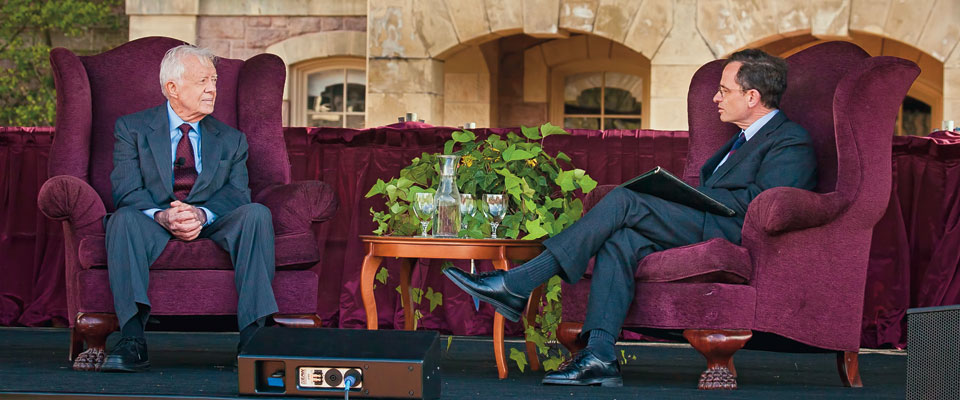
During a question and-answer session, President Carter said peace would be more possible if U.S. diplomats would just talk openly with their peers in North Korea, Syria, and elsewhere.
by Geoff Gehman ’80 | photography by Chuck Zovko
Being a leader in the world today has become so complex because of “almost uniquely low predictability,” said Tony Blair, former British prime minister and current human-rights activist, when he addressed a crowd of more than 5,000 April 8 in Lafayette’s Kamine Gymnasium. Bank meltdowns in Europe, terrorism in Africa, the threat of nuclear weapons in Iran: no wonder politicians are caught in the crosshairs between short-term politics and long-term policies.
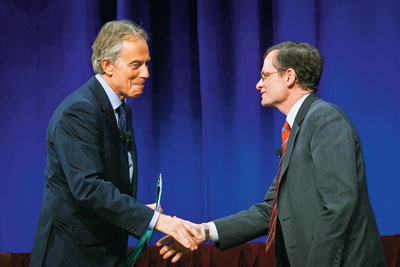 Blair’s robust, revealing Lives of Liberty lecture, underwritten by emeritus trustee Walter Oechsle ’57, focused on being a stable world leader in an increasingly unstable world. His visit was one of three by major world leaders in one month. Jane Goodall, the primatologist and animal-rights advocate, spoke April 11, and Jimmy Carter, 39th President of the United States, gave an address on human rights and democracy April 22.
Blair’s robust, revealing Lives of Liberty lecture, underwritten by emeritus trustee Walter Oechsle ’57, focused on being a stable world leader in an increasingly unstable world. His visit was one of three by major world leaders in one month. Jane Goodall, the primatologist and animal-rights advocate, spoke April 11, and Jimmy Carter, 39th President of the United States, gave an address on human rights and democracy April 22.
Blair supports intervention in foreign crises, an understandable position for an envoy from a quartet of world powers charged with promoting peace in the Middle East and making Palestine a state. It’s important, he said, to help unstable governments evolve rather than revolt, and to generate new jobs for young people particularly on the Gaza Strip, where the average age of residents is 19.
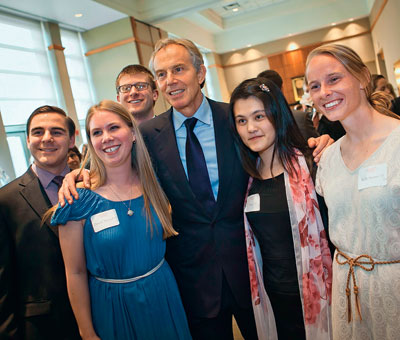
Tony Blair and Paul Hadzewycz ’13 (L-R), Devon Thorsell ’13, Chris Kelly ’13, Yang Li ’13, and Kelly Senters ’13.
According to Blair, new governments must be trained “to tolerate dissent and discord.” The ultimate goal is establishing a “true democracy” with not only open voting but open thinking.
Blair’s Faith Foundation promotes understanding among supporters of major religions. “We’ve got to learn to live with each other and learn from one another,” said Blair, who was 12 or 13 when he met his first nonwhite person. Leaders need to promote the idea that “a wide variety of colors and faiths is actually a strength for our world and not a weakness or a threat.”
“We’ve got to learn to live with and learn from each other. A wide variety of colors and faiths is a strength for our world, not a weakness or a threat.”
— TONY BLAIR
During a reception Blair led a 15-minute summit on world politics with seven students. He discussed international currency with Yang Li ’13, who is writing a paper on the dollar’s global power. He discussed giving more sovereignty—but not independence—to Northern Ireland, Wales, and Scotland with Hamish MacPhail ’13, who last year interned with the Scottish Parliament.
Three days later, Jane Goodall told a story illustrating the emotional bond between humans and chimpanzees, an essential link she’s made famous over a half-century.
She recalled a man who climbed over a zoo barrier to save a scared chimp from drowning, protecting both of them from a posse of wilder, angrier chimps. He risked his life, he explained later, basically because he saw human fear in the animal’s eyes. Goodall saluted his compassion as a prime example of the need to protect all beings, whether it’s an abused circus elephant or a child in a refugee camp.
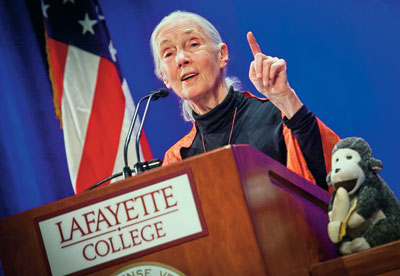 The spellbinding anecdote capped Goodall’s stirring Jones Visiting Lecture, which she delivered in a packed Kamine Gym. Speaking eight days after her 79th birthday, she described her groundbreaking discoveries about the traits chimps share with humans, her crusade to enrich poor villages while preserving wild habitats in Africa, and her wildly popular program to teach young people how to save the planet.
The spellbinding anecdote capped Goodall’s stirring Jones Visiting Lecture, which she delivered in a packed Kamine Gym. Speaking eight days after her 79th birthday, she described her groundbreaking discoveries about the traits chimps share with humans, her crusade to enrich poor villages while preserving wild habitats in Africa, and her wildly popular program to teach young people how to save the planet.
Goodall visited Lafayette a year after Anne Kaplan ’15 suggested her as a guest speaker to President Daniel H. Weiss during a Marquis Scholars dinner. Kaplan, a policy studies major, views Goodall as a triple threat: a popular scientist, an influential activist, and a magnetic role model for youth. Kaplan has been raising money for Roots & Shoots, Goodall’s youth education-andactivism foundation. Last year the Beijing chapter employed Rebecca Slotkin ’14, whose duties included running a gala starring Goodall.
During a reception, Goodall had an especially spirited conversation with Rex Ahene, professor of economics, who wrote Tanzania’s policy for better land use, including supervision of private-property rights. They discussed their mutual concern for protecting gorilla habitats in Rwanda and Uganda from oil developers.
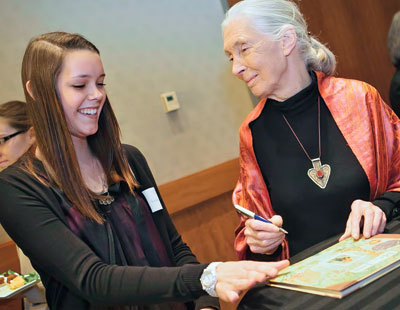
Jane Goodall signs a book for Jordan Close ’14.
In 1960, Louis Leakey sent Goodall to observe chimpanzees in Tanzania’s Gombe Stream National Park. She made her first pivotal discovery: a male chimp using a blade of grass to remove termites from a mound. What was a simple act to David Graybeard was profound to primatologists. For the first time it was proven that chimps make tools with independent thinking.
Goodall made other radical discoveries that established chimps as humans’ closest living relatives. She observed that they eat meat, commit violent acts, adopt strangers, kiss, laugh, dance in the rain. “We’re not the only beings,” she said, “with personalities, minds, and emotions.”
Goodall left Gombe in 1986, compelled by a desire to tell the world of the need to protect chimps and their human neighbors. Since then she’s been traveling up to 300 days a year, raising money and awareness for many causes.
Shannon Moran ’14, an English/music major who hopes to start a Roots & Shoots chapter at Lafayette, was impressed by Goodall’s message about nature’s power to regenerate species, to turn hopelessness into hope.
Goodall’s cross-curricular credentials impressed Steven Mylon, a member of the steering committee that selected her as a Jones Lecturer. The associate professor of chemistry considers her a role model for a college increasingly dedicated to interdisciplinary studies, conservation, and global citizenship.
On April 22, Robert Pastor ’69 had his best homecoming ever.
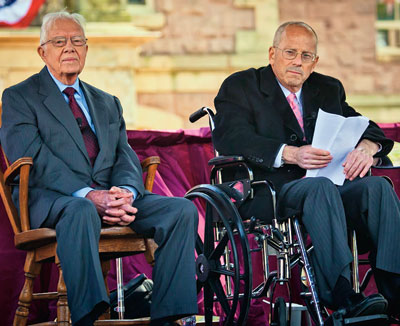
Robert Pastor ’69 (right) reunites with President Jimmy Carter for whom he served as national security adviser.
The renowned diplomatic scholar launched an annual Lafayette lecture series in international affairs that he endowed with his wife. He introduced the first guest speaker, Jimmy Carter, the former president and his former boss. The two ambassadors discussed their global humanitarian campaign on the campus where Pastor started becoming a global citizen.
This rare alliance took place on a covered stage by Pardee Hall, where Pastor studied world history. Pastor opened the program by describing Carter as a bravely visionary president, an evolution he witnessed as Carter’s national security adviser on Latin America and the Caribbean.
Pastor praised Carter for brokering a peace agreement between Egypt and Israel, the latter’s only peaceful treaty with a Middle East rival. Carter, he pointed out, helped normalize U.S. relations with China, enabling the Communist country to chart an international course, and actively opposed tyranny in all nations.
Carter is “a relentless peacemaker” devoted to ending poverty and powerlessness, said Pastor, who directs American University’s Center for North American Studies and Center for Democracy and Election Management. The 2002 Nobel Peace Prize recipient, he added, is “the greatest man I’ve ever known.”
Carter returned the favor by thanking Pastor for establishing an “aggressive” and a “brilliant” human-rights policy during his presidency. It was Pastor, he insisted, who really convinced then-Cuban President Fidel Castro to free nearly 4,000 political prisoners, who closely monitored nearly 650,000 elections in Chinese villages outside Communist jurisdiction, who more than anyone helped change dictatorships to democracies throughout Latin America.
Carter acknowledged Pastor as a key consultant to The Carter Center, a major human-rights ally for more than 20 years. Pastor, he pointed out, helped him bring democracy to Nicaragua and Indonesia. The Carter Center’s mission is to relieve suffering around the world. Carter spoke proudly of eradicating diseases and epidemics in Africa.
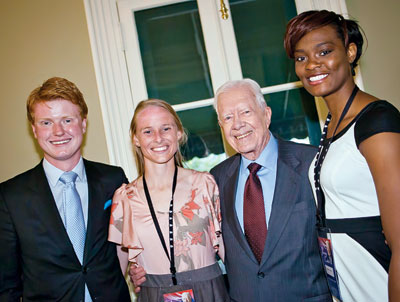
Student Government President Michael Prisco ’14 (L-R), Kelly Senters ’13, and Samantha Jordan ’13 were among the students who met President Jimmy Carter.
Carter criticized American leaders for hawking war. This past January, he tried to think of places where the U.S. promoted peace while he traveled to the second inauguration of President Barack Obama. He couldn’t think of one. He posed the same question to John Kerry, a former presidential candidate and the new Secretary of State. According to Carter, Kerry drew a blank, too.
Katalin Fabian, associate professor of government and law, was impressed by how Carter has popularized unpopular causes: engaging China as a superpower; empowering women; championing human rights for every country, including non-allies.
Tanner Flanigan ’14 was impressed by how Carter has tried to reduce genocide in countries like Somalia. Carter was the first former U.S. president to visit Lafayette since George H.W. Bush, who received an honorary degree during 1998 Commencement.
Pastor said he established the lecture series in international affairs to reward Lafayette for making him aware of international affairs. He expects that Carter’s speech will “switch on” the minds of students the way his undergraduate mind was “switched on” by speeches by consumer watchdog Ralph Nader and Yippie leader Jerry Rubin. “I want to give them an opportunity to listen to people who have influenced the world,” he said, “in the hope that one day they can influence the world.”